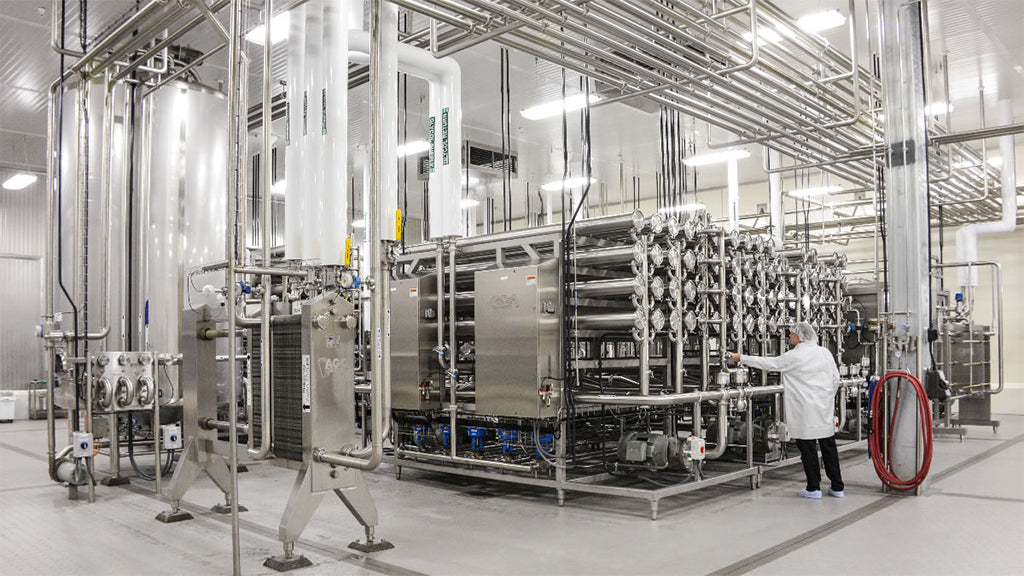
How is whey protein manufactured?
Simply put, whey protein powder is a by-product of the cheese-making industry. Whey protein originally starts with cow’s milk, which naturally contains two main types of protein, casein and whey, at respective ratios of 80% and 20%. During the cheese-making process, the milk is heated to kill unwanted bacteria. The rise of temperature splits the milk into curds and liquid whey.
After separation the curds are strained, the leftover is liquid whey. In its original liquid state, whey is a mixture of mostly water with some protein, fat, carbohydrates and lactose. Whey then undergoes a multi-step filtering and drying process to be turned into protein powder.
Step by step process
From cows grazing the lush pastures of New Zealand to flavoured protein blend canister delivered to your door, let’s dive deeper into each step of how whey protein powder is made.
1. Cow’s milk:
Whey protein is an animal-based product obtained from the dairy industry. Fresh milk is collected from cow’s who, in our case, live most of their life in the open air in New Zealand. This is particularly important as it means these cows are farmed without any antibiotics and growth hormones (Rgbh) and are only grass-fed. It ensures the quality of the milk is as high as can be. In its raw state, milk contains about 5% lactose, 4% fat and 3.5% protein.
2. Transport:
Cooled milk is transferred to the closest factory in large refrigerated tanks.
3. Pasteurization:
Freshly milked from cows, milk contains bacteria that can be harmful to humans. It needs to be pasteurized before it is ready for consumption. To kill pathogens, the milk is briefly heated to high temperature (~73°C), then cooled rapidly. The important nutrients in milk are not affected by heat, only bacteria is removed during the process. After pasteurization, the milk obtained has 20 % whey and 80 % casein and is ready for transformation.
4. Milk Separation:
Enzymes such as Chymosin are added to the pasteurized milk to alter the casein micelle structure and make the milk curdle. The main part of the milk turns into curds. This solid part of milk is used as the base product for a long list of different cheeses. The remaining part is the liquid whey.
5. Micro-filtration:
Liquid whey is sent to be filtered to high-protein liquid whey. During this step, whey goes through further purification to remove fats, carbohydrates and water. In a protein manufacturing plant, liquid whey is filtered through an array of ceramic micro-filters. This process happens in a cold environment and is completely natural. This process removes most fat and lactose from the liquid whey. The resulting product is the base of whey protein concentrate.

6. Ultra-filtration (for WPI only):
Whey concentrate is ultra-filtered to make whey protein isolate. Working by size exclusion, the ultra-filtration membrane lets the lactose-rich solution go though but retains the larger whey complex. At this stage, virtually all fat and lactose are removed.
7. Spray Drying:
The high-protein whey liquid is put into a dryer. Under the influence of hot and cold air, the water is rapidly removed. The correct spray drying process also ensures that whey doesn’t lose its nutritional value and the protein doesn’t get denatured. When the residual moisture has evaporated.
8. Quality Control:
The unflavoured whey protein powder is then tested for quality. The amount of protein is strictly measured. The final product contains 80 to 90% protein.
9.Blending:
The plain whey protein powder is packaged and transferred to the last facility, where it gets blended with other ingredients. Go Good only add organic flavours sourced from fruits and superfoods, thaumatin - a potent natural sweetener and non-GMO sunflower lecithin (for better solubility in liquids).
10. Packaging:
Finally, the flavoured whey protein powder is packaged and sealed into 1Kg recycled cardboard canisters. A sample of every batch is sent for testing to a lab, which uses an infra-red machine to precisely measure the amounts of protein, fat, carbs, amino acids, etc.
Fun Facts
- It takes about 200L of milk to produce 1Kg of whey protein powder.
- Generally, 100L of milk produces about 12Kg of cheese or about 3Kg of casein.
